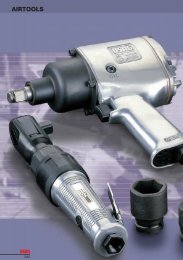Industrial seal self study guide - SKF.com
Industrial seal self study guide - SKF.com
Industrial seal self study guide - SKF.com
You also want an ePaper? Increase the reach of your titles
YUMPU automatically turns print PDFs into web optimized ePapers that Google loves.
Chapter 8—Installation<br />
The <strong>seal</strong> is ready to be installed in the bore once the shaft and bore<br />
have been checked and cleaned, and the <strong>seal</strong> has been pre-lubricated.<br />
Be sure to keep the work area and tools clean. Do not unbox the <strong>seal</strong><br />
until immediately prior to installation. Be careful not to introduce any<br />
contaminants into the <strong>seal</strong> or bearing cavity (fig. 8a).<br />
Inspect the Shaft and Housing<br />
Remove any burrs or nicks which could damage the <strong>seal</strong> lip or score<br />
the O.D. Make sure that the housing and shaft have a smooth,<br />
chamfered edge.<br />
Pre-Lubrication<br />
The lip of the <strong>seal</strong> must be pre-lubed with clean lubricant<br />
before the <strong>seal</strong> is installed. The <strong>seal</strong> O.D. of metal cased <strong>seal</strong>s can<br />
be oiled or installed dry. However, rubber O.D. <strong>seal</strong>s must always be<br />
pre-lubricated. This step is important because pre-lubrication aids<br />
mounting and provides a film on which the <strong>seal</strong> rides until there is<br />
ample lubricant in the <strong>seal</strong> cavity.<br />
The best pre-lube to use is the lubricant being retained. This<br />
precaution can prevent any problems occurring by mixing two different<br />
lubricants together.<br />
Choosing an improper pre-lube could damage the <strong>seal</strong> lip, causing it to<br />
shrink, swell or soften. By using the same lube as that being retained,<br />
you can eliminate the possibility of selecting a lubricant with a limit of<br />
200°F (93°C) for an application where the temperature might run as<br />
high as 250°F or 300°F (121°C to 149°C).<br />
Proper Installation Procedures<br />
The first step in installation is to confirm that the <strong>seal</strong> meets the<br />
specific application requirements. Always be sure to check the<br />
dimensions, orientation of lip, helix direction, and condition of lip<br />
before pre-lubing.<br />
To assist in mounting, always be sure to lube the O.D. of rubber<br />
covered <strong>seal</strong>s. A light lube can also assist in the mounting of metal<br />
clad <strong>seal</strong>s.<br />
Tools<br />
The best method for <strong>seal</strong> mounting is to use an arbor or hydraulic<br />
press that applies uniform pressure against the <strong>seal</strong>. Always use a<br />
proper size tool to apply installation force. If a press is not available or<br />
not practical, use the second best alternative—a round tool. A bearing<br />
cup is excellent. If it must follow the <strong>seal</strong> into the bore, it should be<br />
slightly smaller than the outside diameter of the <strong>seal</strong>. An O.D. .010”<br />
(.25mm) smaller than the bore is ideal.<br />
Before installing the <strong>seal</strong>, check to see<br />
that the shaft and bore are cleaned and<br />
the <strong>seal</strong> is pre-lubricated (fig. 8a).<br />
67<br />
8







